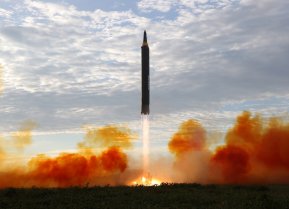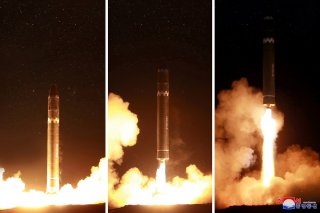Hwasong-15: The Real North Korea ICBM Threat?
The new so-called Hwasong-16 ICBM has some obvious problems and has never been flight-tested. This is why we shouldn't overlook another missile that was also paraded on October 10th.
North Korea unveiled a new “monster” ICBM earlier this week at a military parade commemorating the 75th anniversary of the North Korean Workers’ Party. The tightly choreographed reveal was met with fevered interest from a large subset of western observers, who concluded that the so-called ‘Hwasong-16’ jeopardizes South Korean security and could even pose a “direct and dangerous” threat to the United States. A common strand has emerged from the defense analysis of the past several days: the new missile is a bigger and more capable successor to the Hwasong-15, North Korea’s previous flagship ICBM. But a closer look at both missiles paints a more complex picture, revealing a design gap that points to serious deficiencies in North Korea’s new ICBM.
The National Interest’s Harry Kazianis made a compelling case in a recent Newsweek article that reports of the Hwasong-16’s prowess are greatly exaggerated, outlining its many technical deficiencies. Its colossal size is a major liability, requiring a similarly large and unwieldy transport-erector launcher (TEL) vehicle for transport. It can’t get very far and only has a small number of available travel paths due to North Korea’s poor road infrastructure, making it easier for U.S. and ROK military intelligence to predict its movement patterns and take appropriate countermeasures. The new missile is also liquid-fueled, a baffling design choice that defies the expectations of the White House and Korea experts alike. Whereas a more advanced, solid-fuel ICBM can be fired at a moment’s notice, deploying a liquid-fueled missile such as the Hwasong-16 can take up to 18 hours--this not only limits this ICBMs strategic value as a second-strike nuclear weapon, but provides U.S. forces with a large window for a preemptive strike.
So, where does this leave the older Hwasong-15?
To begin with, it’s markedly smaller and therefore more mobile; it still suffers from all the deployment drawbacks of a liquid-fueled missile, but its movements are at least more difficult to track. Notwithstanding the size difference, the Hwasong-15 carries an impressively large payload of approximately 1,000 kg and is credibly able to threaten large swathes of the U.S. mainland. The Hwasong-15 also incorporates a substantially improved control system over its Hwasong-14 predecessor, allowing a greater degree of precision.
The bigger Hwasong-16 likely boasts a significantly larger payload than its Hwasong-15 counterpart, but what strategic value does that bring?
What concrete goals can North Korea accomplish with, say, a 2,000 kg payload, that it can’t accomplish with the Hwasong-15’s 1,000 kg payload?
If Pyongyang’s goal is to increase the potency of its nuclear missiles, then a more productive short-term project would be to improve on the Hwasong-15 with penetration aids and re-entry vehicle enhancements to strengthen the odds of successful payload delivery. One idea would be to consider working towards shrinking down further the size of the DPRK's warheads to pack more into the nosecone, thus not having to rely on these new features potentially only be added on to just the Hwasong-16, one of the main reasons this missile is so massive, according to many experts. The Hwasong-15 has also been tested at least once and may prove a safer bet as a reliable platform.
If North Korea’s long-term objective is to build a survivable and flexible nuclear force, then branching out into solid-fuel ICBM technology is a sounder investment than putting an even larger payload on already-powerful liquid-fueled missiles. But even as the DPRK acquires more missiles, it likely continues to suffer from a chronic TEL shortage that’s preventing it from widely deploying the missiles it already has.
The Kim Jong-un regime’s new ICBM is, in many ways, a step backward for North Korean missile technology. It solves none of the salient problems plaguing North Korea’s nuclear weapons roster, introducing new ones instead. Hardly a compelling military innovation, the Hwasong-16 is perhaps best understood as an expression of Soviet-style nuclear gigantomania— a preoccupation with ever-larger warheads as a symbol of political authority and international prestige.
Mark Episkopos is a frequent contributor to The National Interest and a PhD student in History at American University. Image: A view of the newly developed intercontinental ballistic rocket Hwasong-15's test was successfully launched is seen in this undated photo released by North Korea's Korean Central News Agency (KCNA) in Pyongyang November 30, 2017.


